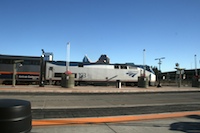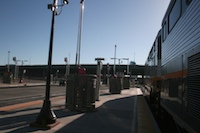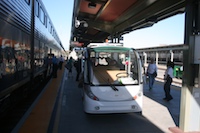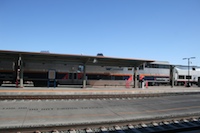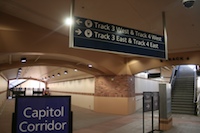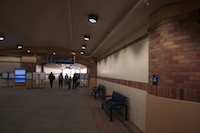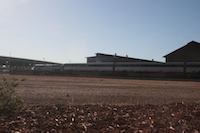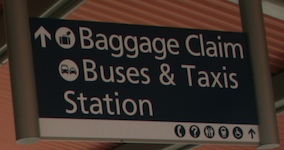

 Davis, CA Davis, CA | Coast Starlight | Chico, CA  |
| California Zephyr | Roseville, CA  | |
| Capitol Corridor | San Joaquin | Lodi, CA  |
Sacramento Valley Station is the second-busiest Amtrak station in California with just over a million people using the station in fiscal year 2012. Train service is provided by the daily Coast Starlight and California Zephyr stopping at the station as an intermediate stop, plus the 15 weekday and 11 weekend Capitol Corridor trains (all originate/terminate at the station except for the one round-trip that's extended to Auburn) and the two daily San Joaquin trains to and from Bakersfield.
Trains currently stop at new modern platforms on relocated tracks 500 feet north of the original station platforms. Trains shifted operations to the new platforms on Monday, August 13, 2012. The reason for the move was the first phase of the Sacramento Intermodal Center project on the site of the massive rail yard that originally surrounded the Sacramento station. For now, Sacramento has plans to redevelop the historic station and move the Amtrak station services into another building, Amtrak is still using the original historic station building with passengers required to make a long walk down a covered path through the former rail yards construction site. Electric cart service is available for those unable to walk. Station staff operates the carts; not a separate group of red caps that operate this service at other major stations.
The new modern platforms consist of two island platforms each for two through tracks. These are numbered 3, 4, 5 and 6 with directions E and W indicated for the shorter California Car trainsets used by the Capitol Corridor and San Joaquin. During overnight hours when trains layover in the station trains will double up with two trains sharing the same track. The station departure monitors will display 6E or 6W, for example. The long-distance Coast Starlight and California Zephyr take up an entire platform and normally stop on one of the middle tracks 4 and 5 because these have a wide service platform in between them (complete with trash dumpsters) so trains can be serviced (particularly the Coast Starlight) without inconveniencing passengers.
The platforms are covered for most of their lengths except the extreme ends by a canopy structure. This structure has white and green supports with a light red canopy (in the style of the bricks of the historic station). Modern silver benches dot all of the platforms. All lighting is extremely modern LED fixtures. Signage is modern blue and silver signs that say Sacramento in the modern format hanging from the platform canopy. Directional signs into the station are in a similar style. Each track has LED signs that default with the date and time but display the name, number and destination of a boarding train.
An underground pedestrian tunnel connects the platforms. It is the only legal way to reach the trains. It has two ramps up to each platform. These ramps are labeled on signs as East and West. A lone staircase is directly up at the start of the East ramp. Inside the pedestrian tunnel are cream-colored walls with brick accents. Decorative black letters say "5 track 6" up each of the ramps up to each platform. To reiterate the proper track LCD signs are everywhere (and also in the main station) some for departures, some for track assignments so getting track information is extremely easy. In addition station staff sets up signs for San Joaquin (always boards from the east side of a track) or coaches or sleepers for the Starlight and Zephyr to indicate which ramp to use up to the platform. The north end beyond the platforms leads to a fenced off emergency exit staircase.
To finally leave the station, passengers walk south underground a bit before reaching the south end of the tunnel. Here a ramp leads up to the surface. Lettering on top of the portal to the underpass has black text: "Sacramento Valley Station To All Trains". The ramp leads up to the surface and to a long 500 foot long walking path that meanders its way through the construction site on the former rail yards. In the middle of the path is a 'rest area' with a couple benches, water fountain, a QuikTrak Machine and an Amtrak California information kiosk (unstaffed). The path is completely covered by a modern canopy in the same style as the one on the platforms. Along the path is some greenery with various trees and shrubs with labels for the respective plants. The path eventually crosses the now abandoned original two platforms. These platforms have had their tracks removed but are otherwise intact, complete with the LED train information signs still on and listing the next departures from the new platforms. The PA system is still on these platforms with the various security and other announcements displayed and played. The covered walk finally ends where passengers cross the VTA light rail tracks (that long-range plans also propose moving) before reaching the crosswalk of H Street and the Amtrak station is now across the street. The baggage claim area and place to wait for cart service out to the platforms is here outside the station.
The 19 trains in each direction per day terminating, originating or stopping in Sacramento is a development only from the last couple decades. When Amtrak began operations in 1971, only one triweekly train served Sacramento; the long-distance California Zephyr called by its processor names the City of San Francisco and later San Francisco Zephyr. The Coast Starlight didn't serve Sacramento until April 25, 1982. Before it operated on a different alignment via the West Valley Line branching off the line used today in Davis to head north. Bus service (operated by Regional Transit, the local transit agency) was advertised connecting in Davis for Sacramento. Except for the short-lived Spirit of California that operated between 1981 and 1983 on an overnight schedule for here to Los Angeles, service through the 1980s continued to be just the two long-distance trains. There was connecting bus service to Stockton to catch the two daily San Joaquin round-trips.
It took until December 12, 1991 for what were then called the Amtrak Capitols to enter service making three round-trips per weekday to San Jose and one north to Roseville. Today this service has evolved into the Capitol Corridor with the most frequent Amtrak service outside of the Northeast between here and Oakland (7 daily trips extended to San Jose, and one trip extended north to Auburn). Service directly south on the San Joaquin from Sacramento to Bakersfield not by connecting bus finally began with one daily trip in February 1999 with the second trip that continues to this day added in March 2002. These San Joaquin trains leave the station in the eastward direction, the opposite direction of the Capitol Corridor trains and head east a bit before curving south off the line used by the California Zephyr and Capitol Corridor to and from the Sierras towards Bakersfield.
Amtrak California Thruway Bus service to Stockton is still provided to the other 4 San Joaquin daily trains that run to and from Oakland. Other connecting bus routes (each operating three times per day) supplement the Coast Starlight to and from Redding and the California Zephyr to Reno and Sparks, Nevada. There is one final thruway bus that runs once per day to the South Lake Tahoe Area (and the only California Route that allows non-rail related travel because there isn't an alternate locally run or for profit route). These buses don't stop anywhere near the new rail platforms, instead they stop in same driveway between the original platforms and historic depot where they always have.
Photos 1-31 taken on 16 June, 2013, 32 on 17 June, 2013, 33-59: 18 January, 2014, 60-64: 19 January, 2014; 65-73: 17 January, 2015
